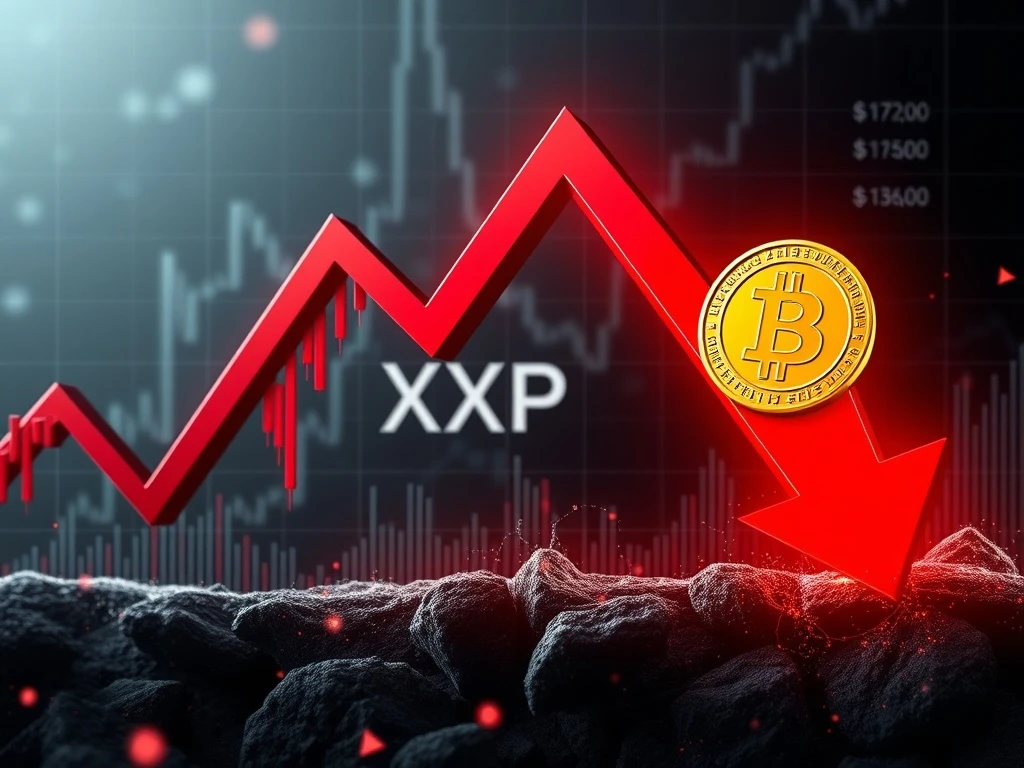Urgent Bitcoin Price Drop: BTC Plunges 3% Amid Massive Institutional Outflows

The cryptocurrency market is once again showcasing its inherent volatility, with Bitcoin, the leading digital asset, experiencing a significant and urgent pullback. In the past 24 hours, the Bitcoin Price Drop has been a focal point for investors, as BTC dipped nearly 3% to approximately $115,376. This marks its lowest valuation in two weeks, a notable erosion of nearly $4,000 from its recent peak of $119,291 just a day prior. This sudden shift has left many wondering about the underlying causes and what this means for the broader crypto landscape.
Understanding the Dynamics of Institutional Outflows
One of the primary drivers behind this latest downturn appears to be substantial Institutional Outflows. Blockchain data reveals that large Bitcoin holders, often referred to as ‘whales’ or institutional entities, have been actively engaged in profit-taking. A prime example is Galaxy Digital, a prominent asset management firm, which reportedly transferred a staggering 30,000 BTC. Valued at approximately $1.15 billion at the time of transfer, these funds were moved to centralized exchanges and over-the-counter (OTC) platforms. Such movements typically signal an intent to sell or reallocate assets, increasing selling pressure on the market.
The scale of Galaxy Digital’s movements is particularly noteworthy. While the firm still retains a significant holding of 18,504 BTC (equivalent to about $2.14 billion at current prices), analysts like Sani from Timechainindex estimate that Galaxy’s total Bitcoin sales from older wallets over the past week alone could have reached an astonishing $8 billion. These massive transfers highlight the considerable influence institutional players wield over market dynamics. When large sums of Bitcoin are moved to exchanges, it typically increases the available supply for sale, potentially overwhelming demand and leading to price depreciation. The speed and sheer volume of these transfers have undoubtedly contributed to concerns about sustained downward pressure in the short term, as the market absorbs this liquidity influx.
Historically, institutional movements have often preceded significant price shifts. When large entities accumulate, prices tend to rise; conversely, when they distribute, prices often fall. The current situation underscores the importance of monitoring on-chain data and institutional flow metrics to gauge market sentiment and potential future movements. The move to OTC platforms, while less transparent than exchange transfers, also suggests large, pre-arranged block trades that can bypass direct exchange order books but still contribute to overall market supply.
The Impact of BTC Profit-Taking on Market Stability
The concept of BTC Profit-Taking is a natural part of any market cycle, especially after periods of significant gains. Large Bitcoin holders, having accumulated their assets at lower prices, often choose to realize profits when prices reach certain psychological or technical thresholds. This recent wave of selling is seen by some as a classic example of this behavior. When ‘whales’ decide to offload substantial portions of their holdings, it creates an immediate supply shock that smaller buyers may not be able to absorb, leading to price declines.
This behavior is often a response to an ‘overheated’ market. An overheated market is characterized by rapid price appreciation, high leverage in trading positions, and a surge in speculative activity. While exciting for investors, such conditions are often unsustainable in the long run. The recent peak of $119,291 might have triggered automated profit-taking mechanisms or strategic decisions by institutional investors to de-risk their portfolios. The market’s reaction, in turn, can cascade, leading to further selling as other investors, both institutional and retail, react to the initial downturn.
The effect of such widespread profit-taking extends beyond just price. It can also impact market liquidity and sentiment. When large amounts of Bitcoin are sold, it reduces the overall liquidity available for buying at those price levels, making it harder for the market to recover quickly. Furthermore, the fear of further declines can lead to a ‘wait-and-see’ approach from potential buyers, exacerbating the downward trend. However, this process can also be viewed as a necessary ‘reset,’ flushing out excess leverage and creating healthier market conditions for future growth.
In-Depth Crypto Market Analysis: Expert Perspectives
For a comprehensive Crypto Market Analysis, it’s crucial to consider the perspectives of leading analysts. Valentin Fournier, lead research analyst at BRN, characterized the market’s recent performance as a “potentially healthy reset” following an extended period of overheating. This viewpoint suggests that the current correction is not necessarily a sign of a looming bear market but rather a natural rebalancing mechanism. Fournier noted a weakening in trading momentum and a slowdown in Bitcoin ETF inflows, both indicators of a broader market cooldown. He further forecasted that Bitcoin could retest the crucial $110,000 support level within the next few trading sessions, as excess long positions are liquidated. Liquidation refers to the forced closing of leveraged trading positions when the market moves against the trader, which can accelerate price declines.
Dean Chen, a crypto analyst at Bitunix, offered a complementary perspective, attributing the broader market correction to a “liquidity sweep” targeting overleveraged long positions. A liquidity sweep is a market maneuver where large players push prices down to trigger stop-loss orders and liquidations from traders holding highly leveraged long positions. This action effectively ‘sweeps’ liquidity from the market, allowing these large players to potentially re-accumulate assets at lower prices. Chen emphasized that despite the volatility, key support levels remain intact, with no major breakdowns observed. This suggests that the market remains in a consolidation phase rather than entering a full-blown bear market. He optimistically added that renewed accumulation could emerge once current uncertainties subside and the market finds its new equilibrium.
These expert views highlight a critical debate within the crypto community: Is this a temporary, albeit sharp, correction, or the beginning of a more prolonged downturn? The distinction is vital for investors. A correction is generally a short-term price pullback within a larger uptrend, often seen as an opportunity to buy the dip. A bear market, conversely, implies a sustained period of declining prices, driven by fundamental weaknesses or a shift in overall market sentiment.
Navigating the Current Market Consolidation
The current environment can be best described as a period of Market Consolidation. This phase typically follows a significant price move and is characterized by prices trading within a relatively narrow range as the market digests recent events and participants reassess their positions. During consolidation, volume often decreases, and volatility might subside, signaling a period of indecision before the next major move.
It’s important to note that the downward trend has not been exclusive to Bitcoin. Altcoins, which often mirror Bitcoin’s price movements, have also recorded declines. Cryptocurrencies like XRP, Solana, and Dogecoin have seen their values align with Bitcoin’s slump, reinforcing the idea of a broader market correction. This correlation is common in the crypto space, where Bitcoin’s dominance often dictates the overall market direction. When Bitcoin falters, altcoins typically follow suit, often with amplified percentage losses due to their higher beta.
However, there was a notable exception: Ethereum (ETH). During the same period, Ethereum bucked the trend, rising by roughly 2% to $3,722. This divergence could be attributed to several factors, including its strong ecosystem, ongoing developments (such as potential future upgrades), and persistent institutional interest, especially with the anticipation of spot Ethereum ETFs. Ethereum’s resilience in a declining market suggests that it might be decoupling to some extent, driven by its unique fundamentals and specific narratives.
The market’s ability to hold above critical support levels will be paramount in determining its next phase. For Bitcoin, the $110,000 level is currently a psychological and technical battleground. Technical indicators suggest that a successful defense of this level could stabilize the market, potentially setting the stage for a rebound or a prolonged period of sideways trading. Conversely, a decisive break below $110,000 could trigger deeper corrections, as stop-loss orders are hit and market confidence erodes further, potentially pushing Bitcoin towards lower support zones.
Challenges and Opportunities in a Volatile Market
The current market conditions present both challenges and opportunities for investors. The primary challenge is the heightened volatility and uncertainty, making it difficult to predict short-term price movements. Large-scale institutional selling raises concerns about potential liquidity pressures, particularly if market sentiment deteriorates further. Investors might face increased risks of liquidation if they are overleveraged, and the general sentiment can shift rapidly from optimism to fear.
However, such corrections also create opportunities. For long-term investors, a significant Bitcoin Price Drop can be viewed as a chance to accumulate more assets at discounted prices. This aligns with the ‘buy the dip’ strategy, where investors purchase assets during temporary downturns, anticipating future appreciation. The concept of a ‘healthy reset’ implies that the market is shedding unsustainable elements, paving the way for more organic and sustainable growth in the future. The liquidation of overleveraged positions cleanses the market, reducing systemic risk and creating a more stable foundation.
Moreover, periods of consolidation and correction can provide clarity on which assets are truly resilient. Ethereum’s performance, for instance, highlights its underlying strength and unique value proposition. Investors can use these times to re-evaluate their portfolios, reduce exposure to highly speculative assets, and focus on projects with strong fundamentals and clear use cases.
Looking Ahead: Key Factors to Monitor
As the market navigates this period of uncertainty, several factors will be crucial for investors to monitor:
- Institutional Activity: Keep a close eye on on-chain data for signs of renewed institutional accumulation or continued distribution. Large inflows into exchange wallets could signal further selling pressure, while outflows might indicate accumulation. Monitoring institutional investment products like Bitcoin ETFs for sustained inflows or outflows will also provide valuable insights.
- Macroeconomic Signals: Broader economic factors continue to exert significant influence on the crypto market. Inflation data, interest rate decisions by central banks (like the Federal Reserve), and geopolitical events can impact investor risk appetite. A hawkish stance from central banks or increasing global instability often leads to a flight from riskier assets like cryptocurrencies.
- Technical Indicators: Beyond the $110,000 support level, investors should monitor other key technical indicators such as moving averages, relative strength index (RSI), and trading volumes. These can provide clues about market momentum and potential trend reversals. For example, a bounce off a key moving average coupled with increasing volume could signal a recovery.
- Market Sentiment: Tools like the Crypto Fear & Greed Index can offer a snapshot of overall market sentiment. Extreme fear can sometimes signal a bottoming out, while extreme greed might precede a correction. Social media trends and news headlines also play a role in shaping collective investor psychology.
- Regulatory Developments: New regulations or enforcement actions in major jurisdictions can significantly impact the crypto market. Clarity in regulation can foster institutional adoption, while restrictive measures can stifle growth and create uncertainty.
The current Market Consolidation phase demands patience and strategic decision-making. While the immediate future for Bitcoin remains uncertain, its ability to defend key support levels will be a critical determinant of its next trajectory. Investors who remain informed and disciplined will be better positioned to navigate the ongoing volatility and capitalize on potential opportunities as the market evolves.
Conclusion
The recent Bitcoin Price Drop, triggered by significant Institutional Outflows and widespread BTC Profit-Taking, underscores the dynamic and often unpredictable nature of the cryptocurrency market. While the immediate downturn has raised concerns, expert Crypto Market Analysis suggests this could be a ‘healthy reset’ or a ‘liquidity sweep’ designed to cleanse the market of excess leverage. As the market enters a period of Market Consolidation, the critical $110,000 support level for Bitcoin will be a key indicator of its short-term trajectory. Investors are advised to closely monitor institutional activity, macroeconomic signals, and technical indicators to make informed decisions. This period of adjustment, while challenging, also presents opportunities for strategic accumulation and portfolio rebalancing, paving the way for a more stable and potentially stronger market in the long run.
Frequently Asked Questions (FAQs)
Q1: What caused the recent Bitcoin price drop?
The recent Bitcoin price drop was primarily attributed to significant institutional outflows and widespread profit-taking by large holders. Specifically, a major asset management firm, Galaxy Digital, transferred a substantial amount of Bitcoin to exchanges and OTC platforms, signaling an intent to sell or reallocate assets. This influx of supply, combined with a market that analysts considered ‘overheated,’ led to increased selling pressure and a notable price decline.
Q2: What are ‘institutional outflows’ and why are they significant?
‘Institutional outflows’ refer to large amounts of cryptocurrency being moved out of institutional wallets or investment products, often to centralized exchanges or over-the-counter (OTC) platforms, typically indicating an intent to sell. These movements are significant because institutional players manage vast sums of capital, and their buying or selling activities can have a profound impact on market liquidity and price. Large outflows can create significant selling pressure, leading to price drops.
Q3: Is this a temporary correction or the start of a bear market?
Analysts hold differing views. Some characterize it as a ‘healthy reset’ or a ‘liquidity sweep,’ suggesting it’s a temporary correction designed to flush out overleveraged positions and create a more sustainable market. They note that key support levels generally remain intact. Others caution that if institutional selling persists and key support levels are broken, it could signal a more sustained downturn. The distinction depends on how the market reacts to the $110,000 support level and broader macroeconomic factors.
Q4: Why did Ethereum (ETH) rise while Bitcoin and other altcoins fell?
While Bitcoin and most altcoins declined, Ethereum bucked the trend with a modest rise. This divergence could be due to several factors unique to Ethereum, including its robust ecosystem, ongoing network developments (such as potential future upgrades), and persistent institutional interest, particularly in anticipation of spot Ethereum ETFs. Its fundamental strength and specific narratives might be allowing it to decouple from Bitcoin’s immediate price movements to some extent.
Q5: What is ‘Market Consolidation’ and what does it mean for investors?
‘Market Consolidation’ is a phase where prices trade within a relatively narrow range after a significant price move, indicating indecision in the market. During consolidation, trading volume might decrease, and volatility could subside as the market digests recent events. For investors, it can be a period to reassess portfolios, manage risk, and potentially look for accumulation opportunities at lower prices if they believe in the long-term prospects of the assets.
Q6: What key factors should investors monitor moving forward?
Investors should closely monitor several key factors: continued institutional activity (inflows/outflows), broader macroeconomic signals (inflation, interest rates, geopolitical events), critical technical support and resistance levels (like Bitcoin’s $110,000), and overall market sentiment indicators. Staying informed on these fronts can help investors make more strategic decisions during volatile periods.










